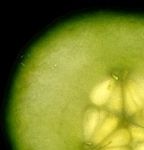Yellow Shoulder: A Ripening Disorder of Greenhouse Tomato Fruit
←
→
Page content transcription
If your browser does not render page correctly, please read the page content below
Neil Mattson
nsm47@cornell.edu
Volume 5 Number 1 January 2020
Yellow Shoulder: A Ripening 2020 Sponsors
Disorder of Greenhouse
Tomato Fruit
A common fruit ripening disorder in greenhouse tomato
production is yellow shoulder also called green shoulder. In this
disorder the top, or “shoulder”, of the fruit adjacent to the
truss stem fails to properly ripen resulting in yellow or green
regions (Fig. 1). Leaving the fruit on the vine to ripen longer
does not alleviate these symptoms. Yellow shoulder/green
shoulder is a physiological disorder that is not well understood.
The disorder is prevalent in greenhouse / high tunnel tomato
production and can also be found under field conditions. This
article will discuss causes of yellow shoulder and cultural
management steps that can be taken to reduce its prevalence.
Figure 1. Yellow/green regions around the upper collar of tomato fruit is a fruit ripening disorder. Photo
courtesy of T.A. Zitter, Cornell University, Ithaca, NY.
www.e-gro.org
1e-GRO Edible Alert - 2020 Yellow Shoulder of Tomato
Symptoms of yellow shoulder expand and progress to become a large
Yellow shoulder appears as yellow, green, necrotic (brown) region. Blossom end rot
or orange regions that fail to ripen and is associated with poor calcium supply to
occur on the upper part of the tomato fruit (primarily due to cultural factors
fruit surrounding the stem. The regions such as poor irrigation management or
may appear as a ring around the entire conditions that limit plant transpiration).
upper part of the fruit or they may be
more isolated as separate region(s) (Fig.
2). Upon slicing through the fruit, the
internal yellow/green/orange regions are
visible (Fig. 3). The cells in the affected
region may be smaller than normal and a
more random arrangement. Green
chlorophyll in the affected region fails to
develop a red pigment. This process
appears to happen early in fruit
development. The rest of the fruit will
ripen to red, but the affected
green/yellow/orange regions will not
further ripen. Therefore, simply leaving
the fruit on the vine longer (hoping the
affected regions will ripen and turn red) Fig. 2. Yellow/green regions around the shoulder of the
tomato fruit. Photo courtesy of T.A. Zitter, Cornell
will not solve this disorder and will only University, Ithaca, NY.
result in over mature fruit.
Related blotchy ripening disorders appear
to have similar causes to yellow shoulder
and overall all of these are referred to as
physiological fruit ripening disorder. The
other examples include internal whitening
in which inner and outer fruit walls
become white and corky, and gray wall in
which the outer fruit wall turns
brown/gray and collapses. Collectively,
these ripening disorders may render fruit
unmarketable or may reduce the fruit
quality grade.
Yellow shoulder and the related ripening
disorders should not be confused with
blossom end rot. Blossom end rot occurs Fig. 3. Cells internal to the fruit surface are
on the bottom, or blossom, end of the yellow/green. Photo courtesy of Neil Mattson, Cornell
University, Ithaca, NY.
fruit and is the opposite end of the fruit
than the shoulder (or top) of the fruit.
Blossom end rot appears as water soaked
regions on the bottom of the fruit that can
www.e-gro.org 2e-GRO Edible Alert - 2020 Yellow Shoulder of Tomato
Tomato at Tomato at Tomato at Tomato sufficiency Tomato sufficiency ranges
Element Stage 1 Stage 2 Stage 3 ranges (transplants) (plants for fruiting)
NO3-N 90 120 190 Min Max Min Max
NH4-N 0 0 0 N% 2.5 5 4.0 5.5
P 47 47 47 P% 0.3 1.0 0.3 1.0
K 144 350 350 K% 4.0 7.0 4.0 7.0
Ca 144 160 200 Ca % 0.9 3.0 1.2 5.0
Mg 60 60 60 Mg % 0.4 1.5 0.8 3.0
S 116 116 116
S% --- --- --- ---
Cl 89 89 89
Fe ppm 50 100 100 250
Fe (EDTA) 2 2 2
Mn ppm 40 100 40 300
Mn 0.55 0.55 0.55
B ppm 30 75 30 120
Zn 0.33 0.33 0.33
Zn ppm 30 100 30 150
Cu 0.05 0.05 0.05
Cu ppm 5 15 5 30
B 0.34 0.34 0.34
Mo ppm 0.15 1 0.15 5
Mo 0.05 0.05 0.05
Na ppm < 200 < 500
Table 1. Three stage nutrient solution for greenhouse tomatoes in
soilless culture from the University of Arizona CEAC (Controlled
Environment Agriculture Center). Details on preparing the Table 2. Sufficiency ranges for elemental tissue analysis of
fertilizer are available from Kroggel and Kubota (2018) at tomato at the transplant stage and for mature plants for
https://ohioline.osu.edu/factsheet/hyg-1437 Stage 1 is from fruiting. Adapted from: Dr. Cari Peters, J. R Peters Laboratory.
seedling until the 2nd truss (flower cluster) is at anthesis (shedding 6656 Grant Way, Allentown, PA 18106; and adapted from:
pollen), State 2 is from the 2nd truss until 5th truss is at anthesis, Jones, J.B. Jr., W. Wolf and H.A. Mills. 1991 Plant analysis
and stage 3 is after the 5th truss is at anthesis through fruiting. handbook. Micro-Macro Publications, Inc. 185 Paradise Blvd,
Suite 108, Athens, GA 30607.
Causes of yellow shoulder
Yellow shoulder appears to be associated with conditions that cause poor potassium (K)
supply to the fruit, however the full cause of yellow shoulder and associated ripening
disorders has not been fully worked out. Yellow shoulder appears to be exacerbated by
high temperatures (>90 °F), low temperatures (4:1), excessive Ca or Mg in the root-zone which can
antagonize or reduce K uptake, excess supply of nitrogen, high humidity and low light.
Cultural control and prevention
It is not possible to correct yellow shoulder (and associated ripening disorders) once the
symptoms have developed and progressed. Therefore prevention of the disorder through
cultural control and careful attention to the plant nutrient management are key. Cultivar
plays a strong role in prevalence of yellow/green shoulder. Work with your seed supplier
to select cultivars that are not sensitive to this disorder.
www.e-gro.org 3e-GRO Edible Alert - 2020 Yellow Shoulder of Tomato Next, one should ensure proper potassium The recommendation is to ensure the supply to the plant and conduct regular Ca:Mg ratio is not lower than 3:1 in the leaf tissue analysis to verify plant K status root-zone. Overall excessive levels of well-before and during the fruiting stage. other cations such as calcium, magnesium, Tomato plants have a higher need for and sodium (Na) can also limit potassium potassium in the fruiting stage and it is availability to the plant. important to ensure proper K supply prior to early fruit set. Nutrient solution recipes Other cultural factors to reduce yellow formulated for tomatoes take this into shoulder include keeping air temperatures account and increase the potassium levels below 90 °F which in warm climates may as the plant goes into the fruiting stage require increased ventilation, evaporative (Table 1). Note that the K target is 144 cooling pads and/or greenhouse shading. ppm when the plant is at stage 1 (seedling Low temperatures (
e-GRO Edible Alert - 2020
e-GRO Alert Cooperating Universities
www.e-gro.org
CONTRIBUTORS
Dr. Nora Catlin
Floriculture Specialist
Cornell Cooperative Extension
Suffolk County
nora.catlin@cornell.edu
Dr. Chris Currey
Assistant Professor of Floriculture
Iowa State University
ccurrey@iastate.edu
Dr. Ryan Dickson
Greenhouse Horticulture and
Controlled-Environment Agriculture
University of Arkansas
ryand@uark.edu
Nick Flax
Commercial Horticulture Educator
Penn State Extension
nzf123@psu.edu
Thomas Ford
Commercial Horticulture Educator
Penn State Extension
tgf2@psu.edu
Dan Gilrein
Entomology Specialist
Cornell Cooperative Extension
Suffolk County
dog1@cornell.edu
Dr. Joyce Latimer
Floriculture Extension & Research
Virginia Tech
jlatime@vt.edu
Heidi Lindberg
Floriculture Extension Educator
Michigan State University
wolleage@anr.msu.edu
Dr. Roberto Lopez
Floriculture Extension & Research
Michigan State University
rglopez@msu.edu
Dr. Neil Mattson
Greenhouse Research & Extension
Cornell University
neil.mattson@cornell.edu
Dr. W. Garrett Owen
Floriculture Outreach Specialist
Michigan State University
wgowen@msu.edu
Dr. Rosa E. Raudales
In cooperation with our local and state greenhouse organizations
Greenhouse Extension Specialist
University of Connecticut
rosa.raudales@uconn.edu
Dr. Beth Scheckelhoff
Extension Educator – GreenhouseSystems
The Ohio State University
scheckelhoff.11@osu.edu
Dr. Ariana Torres-Bravo
Horticulture/ Ag. Economics
Purdue University
torres2@purdue.edu
Dr. Brian Whipker
Floriculture Extension & Research
NC State University
bwhipker@ncsu.edu
Dr. Jean Williams-Woodward
Ornamental Extension Plant Pathologist
University of Georgia
jwoodwar@uga.edu
Copyright © 2020
Where trade names, proprietary products, or specific
equipment are listed, no discrimination is intended and
no endorsement, guarantee or warranty is implied by
the authors, universities or associations.
www.e-gro.org 5You can also read



























































